Home | Category: Early Christian Saints and Martyrs / Saints in Medieval Europe / Christmas
ST. NICHOLAS
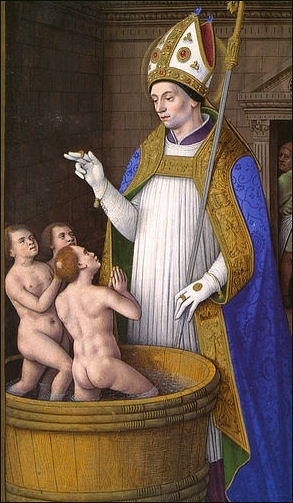
St. Nicholas of Myra, the original Santa Claus, Is arguably the most famous saint in the world. Recognized by non-Christians as well as Christians, he was born and lived present-day Turkey in the 3rd and 4th century. Today he is deeply revered by Catholics and Orthodox Christians and children around the globe and was probably the most popular saint in the Middle Ages.
St. Nicholas’s feast day is December 6th. The Catholic church no longer celebrates it but the Orthodox church does. Over the years St. Nicholas has been honored as the patron saint of children, merchants, travelers, scholars, sailors, prostitutes, moneylenders, pirates, pawnbrokers, and thieves. The Orthodox church honors him as the patron saint of virgins, sailors and pawnbrokers. December 6th has endured in many places as a day of gift giving called St. Nicholas Day.
St. Nicholas gave birth to Saint Nick, Kris Kringle and finally Santa Claus, known to children all over the world. In Russia, St. Nicholas is a protectors of many cities and towns, and most of the ports. He is a protector from thieves and criminals and a guaranteer of debts and justice in this world and the next. A Russian proverb goes: “If God were to die, at least we would still have St. Nicolas.”
One legendary attribute that led to the story of Santa Claus was his habit of giving gifts in secret. Believers say his remains produce a liquid called manna, or myrrh, said to have healing powers. In 1087, Italian sailors spirited the bones to Bari, Italy, where the remains have been kept in a crypt ever since.
Valerie Strauss wrote in the Washington Post: “ It is said his parents died when he was young and that the religious Nicolas, who was raised by his uncle, was left a fortune. Ordained as a priest, he used his money to help others and become a protector of children, performing miracles to help them. He was, the center says, persecuted by Roman Emperor Diocletian and buried in 343 A.D. in a church, where a substance with healing powers, called manna, formed in his grave. The day of his death, Dec. 6, became a day of celebration.” [Source: Valerie Strauss, Washington Post, December 24, 2014 +++]
See Separate Article CHRISTMAS AND HOLIDAYS IN THE CHRISTMAS SEASON factsanddetails.com ; HISTORY OF CHRISTMAS factsanddetails.com
Websites and Resources: Saints and Their Lives Today's Saints on the Calendar catholicsaints.info ; Saints' Books Library saintsbooks.net ; Saints and Their Legends: A Selection of Saints libmma.contentdm ; Saints engravings. Old Masters from the De Verda collection colecciondeverda.blogspot.com ; Lives of the Saints - Orthodox Church in America oca.org/saints/lives ; Lives of the Saints: Catholic.org catholicism.org ; Early Christianity: PBS Frontline, From Jesus to Christ, The First Christians pbs.org ; Elaine Pagels website elaine-pagels.com ; Sacred Texts website sacred-texts.com ; Gnostic Society Library gnosis.org ; Guide to Early Church Documents iclnet.org; Early Christian Writing earlychristianwritings.com ; Internet Ancient History Sourcebook: Christian Origins sourcebooks.fordham.edu ; BBC on Christianity bbc.co.uk/religion/religions/christianity ; Candida Moss at the Daily Beast Daily Beast Christian Classics Ethereal Library www.ccel.org;
RECOMMENDED BOOKS:
“The True Saint Nicholas: Why He Matters to Christmas by William J. Bennett Amazon.com ;
“Stories of the Saints: Bold and Inspiring Tales of Adventure, Grace, and Courage”
by Carey Wallace and Nick Thornborrow Amazon.com ;
“The Illustrated Encyclopedia of Saints: An Authoritative Guide to the Lives and Works of Over 300 Christian Saints” by Tessa Paul and Ronald Creighton-Jobe Amazon.com ;
“Foxe's Book of Martyrs: Pure Gold Classics” by John Foxe, Tim Côté, et al Amazon.com ;
“The New Encyclopedia of Christian Martyrs” by Mark Water Amazon.com ;
“Lives of the Saints” by Alban Butler Amazon.com ;
“How To Become A Saint - A Beginner's Guide” by Jack Bernard Amazon.com ;
“The Life of St. Francis of Assisi by St. Bonaventure and Henry Edward Mannin Amazon.com ;
“The Complete Francis of Assisi: His Life, The Complete Writings, and The Little Flowers” by Jon M. Sweeney Amazon.com ;
“St. Francis of Assisi: A Biography” by Omer Englebert Amazon.com ;
“Joan of Arc” by Mark Twain Amazon.com ;
“Joan of Arc: By Herself and Her Witnesses” by Régine Pernoud Amazon.com
St. Nicholas’s Life
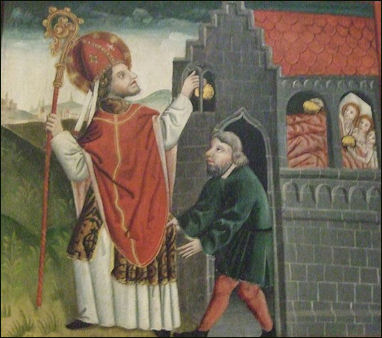 Saint Nicholas was born in A.D. 271 (or 280) in the town of Patara on the south coast of modern-day Turkey into a wealthy, devoutly-Christian family. He family was wealthy enough for him to go on a tour the Holy Land. After that he wanted to escape from his small town and he relocated to the larger Mediterranean city of Myra (present-day Demre), where a series of miracles was attributed to him and he became a bishop at a very young age.
Saint Nicholas was born in A.D. 271 (or 280) in the town of Patara on the south coast of modern-day Turkey into a wealthy, devoutly-Christian family. He family was wealthy enough for him to go on a tour the Holy Land. After that he wanted to escape from his small town and he relocated to the larger Mediterranean city of Myra (present-day Demre), where a series of miracles was attributed to him and he became a bishop at a very young age.
Saint Nicholas converted to Christianity, became a priest as age 19 and a bishop in his 20s. Much of what is known about his life is more legend than fact. “The Golden Legend” , a popular 13th century myth book of the saint’s lives, described Nicholas as pious from birth. He never bothered to crawl. He started walking immediately after he was delivered and refused his mother’s milk and fasted twice a week. While there is no firm evidence of Nicholas of Myra’s early life, another Nicholas, a holy-oracle-working monk at the monastery of St. Sino is documented as living between 480 and around 564. Over time the stories and miracles attributed to each Nicholas merged into one.
Saint Nicholas was imprisoned by the Romans during Emperor Diocletian’s “Great Persecution” for preaching and refusing to renounce his religion. He was tortured, deprived of food and drink and spent 12 years in prison and was released in A.D. 312 when Constantine Christianized the Roman Empire.
St. Nicholas, the Brawling, Benevolent Saint
After inheriting his family's wealth Nicholas decided to use the money to help the poor. Although he was brought up in a period of persecution he fought ferociously against corruption and injustice and even came to the assistance of Roman soldiers who had been unfairly accused. He was known for his generosity and fondness of children and giving away his inherited wealth anonymously to the poor, which helped his transformation into Santa Claus.
Saint Nicholas was also known as being vengeful and full of fight. According to legend to he prayed for bad things to occur to the Artemis-worshipping pagans in his parish. His prayers were answered with the destruction of the Artemis temple in Myra. When the local pagans asked him for some help. He told them, “Go to Hell’s fire, which has been lit for you by the Devil.”
Saint Nicholas made a name for himself in A.D., 325 at the Council of Nicaea, where, during a debate, he punched Arius, a a priest from Egypt who dared to suggest that Jesus was not divine but only a prophet. The Egyptian priest reportedly sustained a black eye while St. Nicholas was set upon by a group of holymen who tore off his robes and threw him in prison. See Below
Saint Nicholas died on December 6th in 326, 342 or 352. He was buried in an elaborate marble sarcophagus. After his death Myra became a popular Christian pilgrimage spot.
Miracles Attributed to St. Nicholas
 A number of miracles were attributed to Nicholas. He reportedly saved of the life of three sailors by calming stormy seas with his prayers. He threw three bags of gold in the windows (or chimney) of a house of three unmarried virgins to rescue them from a life or prostitution. The money was used to provide the girls with dowries and husbands. This story is believed to be the source of the gifts and chimneys stories of Santa Claus. The three bags morphed into three globes or apples which became the saint’s standard symbol in Western art and are the source of the three globes found at pawnbroker’s shops.
A number of miracles were attributed to Nicholas. He reportedly saved of the life of three sailors by calming stormy seas with his prayers. He threw three bags of gold in the windows (or chimney) of a house of three unmarried virgins to rescue them from a life or prostitution. The money was used to provide the girls with dowries and husbands. This story is believed to be the source of the gifts and chimneys stories of Santa Claus. The three bags morphed into three globes or apples which became the saint’s standard symbol in Western art and are the source of the three globes found at pawnbroker’s shops.
Nicholas is also said to have chopped down a demon-possessed tree and resurrected three murdered children who were pickled in brine. According to another legend, a robber entered a tavern and murdered and dismembered three children and placed their remains in barrels, which were pickled, salted and cured for customers to eat. St. Nicholas entered the tavern and was asked if he was hungry. Nicholas replied: not of what the tavern was offering. He then made the dismembered children whole again. This tale led to him becoming the patron saint of children and stories of him giving presents to good children and twigs to naught ones.
Many more miracles were attributed to Nicholas after his death. According to a story from the 9th century, a demon disguised as an old woman told some pilgrims to take some flasks of oil to Myra and light them. The flasks, which contained powerful explosives, were carried aboard a ship. A passenger aboard the ship had a dream that flasks should be thrown overboard, they were and waves burst into flames and the seas boiled but the ship and the passengers were saved. This miracle made Nicholas popular among sailors, who prayed to the saint for safe passage and protection from storms. It is reasoned that Nicholas’s popularity among seamen helped spread his name and legends to ports all over Europe, where he was embraced, popularized and spread further.
In 1057, a prior refused to allow a group monks to sing a honoring St. Nicholas on his feast day. At night St. Nicholas appeared before the prior with a horsewhip and sang the song and continued singing it until the prior learned “to sing the whole song from beginning to end.”
St. Nicholas's Bust-Up at the Council of Nicaea in A.D. 325
On his altercation with Arius, Candida Moss wrote in the Daily Beast: Nicaea is one of the most important Church Councils in Christian history. It was here that the Nicene Creed, the statement of faith spoken or sung on Sundays in Western Christian traditions, was adopted. A somewhat updated version is accepted by most denominations of Christianity as the only authoritative non-biblical doctrinal statement. In other words, it was a big deal. [Source: Candida Moss, Daily Beast, December 11, 2022]
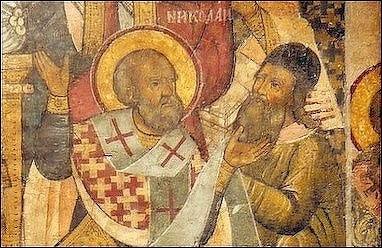
Saint Nicholas of Myra slapping Arius
The impetus for the Council was a doctrinal dispute known as the Arian controversy. Arius was an Egyptian priest based in Alexandria who had gotten into a theological spat with his bishop about the relationship between God the Father (the Creator God) and God the Son (Jesus Christ). As a bishop, Nicholas was invited to attend and participate in the Council of Nicaea. Though not a bishop, Arius was there too and at one juncture Bishop Eusebius (an Arian himself) asked the Emperor for permission to invite the priest to offer a defense of his position. Arius entered and began to read. At first the group listened in silence, but the crowd of attendees soon grew restless, uncomfortable, and even angry. Nicholas took things further. He stood up, walked to where Arius was speaking, and punched him. As a result, he was stripped of his position as Bishop and imprisoned again.
You won’t find a reference to his right hook in any of contemporaneous literature of official church records. On his blog, Roger Pearse has used the work of Gustav Anrich to track down the evidence for the story. The earliest snippet he could find was a brief story attributed to a man named Petrus de Natalibus, a late fourteenth century bishop of Equilio (near Venice). According to Petrus: “It happened that saint Nicholas, now an old man, was present at the Council of Nicaea, and out of jealousy of faith struck a certain Arian in the jaw, on account of which it is recorded that he was deprived of his mitre and pallium; on account of which he is often depicted without a mitre” (Translation from Pearse).
What you’ll notice immediately is that in the earliest version we have, Nicholas isn’t said to have slapped Arius himself but rather “an Arian.” Pearse traces the next stage of the argument to a sixteenth century legend compiled by Damascenos the Monk. This appears to be the first version in which Nicholas squared off against the arch-heretic himself. All of this suggests that it’s highly unlikely that Santa punched Arius if, in fact, he punched anyone at all. The legend first emerges a millennium after the Council of Nicaea and doesn’t, in its original telling, involve Arius. This is just one of the many strange stories that emerged in order to portray Arius negatively.
St. Nicholas’s Body and Icons
The church where St. Nicholas was buried in Myra became a popular pilgrimage site. After his death, St. Nicholas’s sarcophagus was periodically filled with fragrant oil. The oil dripped through cracks in the sarcophagus and was collected by priests who made lots of money selling the oil with claims it had miraculous powers.
In 1087, after Myra was taken over by Muslim, the bones of St. Nicholas were taken by Italian sailors to Bari, Italy, where a massive church was built to house them. There he became the patron saint of children. The theft of the bones from Myra is believed to have been motivated more by money than piety. With no bones to attract pilgrims the church in Myra fell into disrepair and eventually vanished while Bari’s stature grew and a festival was established to celebrate the “Translation of the Relics to Bari.”
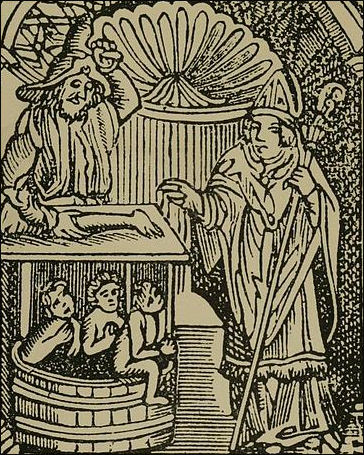
St. Nick and the Schoolboys Since the collapse of the Soviet Union in the 1990s, increasing numbers of East Europeans and Russians have been making the way to Bari to pay their respects. There are even direct flights there from Moscow. There is so much art work devoted to St. Nicholas that entire exhibitions — including one called “St. Nicolas: Artistic Splendors of East and West” in Bari — have been devoted to images of him made through the ages.
St. Nicholas is a popular subject in icon painting. He is thought to have been the first saint to be featured as the subject of a “hagiographical icon” which depicts not only a likeness it also bordering veneers of his life works and miracles. This type of icon appeared in the late 12th century is places St. Catherine’s in the Sinai and Pugilia Italy. Nicholas is often depicted flanked by Christ handing him the gospels and the Virgin Mary giving him his bishop’s stole.
From the sea ports of southern Europe St. Nicholas spread into Russia along river trading routes and reached the pinnacle of his deification, not only being pictured with Christ and Mary but also being described as “The Russian divinity” and the “forth member of the Trinity.” In Russian icons, Nicholas was often pictured with a sword in one hand and a miniature representation of Russian towns in the other and was widely viewed as a protector of the Russian people, especially from the Tatars.
In Bari, St. Nicholas acted as bridge between Catholics and Orthodox Christians and it wasn’t long before he became a Catholic bishop. The establishment of his feast day on December 6th paved the way for its incorporation into pagan winter festivities and seasonal gift-giving in northern Europe. Later Nicholas’s association with children and generosity made him palatable to Protestants. The Dutch, some believe, are the source of stories that Nicholas not only rewards good children but punishes bad ones.
Transformation of St. Nicholas Into Santa Claus
In the Middle Ages, St. Nicholas was pictured as a thin man in a bishop's robes and miter. He was regarded as the brawling saint and was known more for being vindictive and short-tempered than jolly. There were stories about him horsewhipping people even after he died.
Fourteenth-century documents show that children at that time received gifts and students received rewards or reprimands on St. Nicholas's feast day in early December when parents and teachers sometimes dressed up as the beloved bishop.
Word of Nicholas’s good deeds spread to northern Europe where he was transformed into Santa Klaus. After the reformation, Protestants sailed to recognize many Catholic saints, and St. Nicholas became associated with Father Christmas, a mythic Nordic figure who gave out presents to good children.
Dutch sailors adopted St. Nicholas as their patron saint on long voyages. He also became known as gift giver who brought presents to good children and rods to bad ones. The Dutch spelled St. Nicholas "Sin Nikolass" which was later altered to "Sinterklass" (If you say "St. Nicholas" really fast it comes out "Santa Claus"). Appearance-wise he remained a skinny bishop.
Arrival and Commercialization of St. Nicholas and Santa Claus in America
.jpg)
Sinter Klaus St. Nicolas was brought to the New World by Columbus, who named a Haitian port for him in 1492. In the 16th century Dutch immigrants brought "Sinterklass" to New Amsterdam (present-day New York City) where his name was later anglicized into Santa Claus. Many Christians customs were introduced to America by the Germans.
In the 19th Century, Santa Claus was popularized in the United States by the Washington Irving story “History of New York “ and the poem “The Night Before Christmas” by Clement Clarke Moore, a Bible scholar from a wealthy family. Irving’s St. Nick arrived in a flying wagon, smoked a long pipe and wore a “low, broad-rimmed hat” and had the ability to disappear by touching his nose. Moore’s St. Nick was “chubby and plump” and “a right jolly old elf” with a belly that shakes like jelly. He rode in a sleigh puled by reindeer with names like Dancer, Prancer and Vixen.
Moore’s poem helped to link St. Nicholas and Santa Claus with Christmas rather than St. Nicholas Day. Between 1862 and 1886, Santa Claus was pictured as a jolly fat man with a beard and toys in Harper's Weekly magazine in cartoons by Thomas Nast, a German-born political cartoonist who also conceived the Republican elephant and Democratic donkey.
Our present image of Santa Claus is based primarily on the Thomas Nast Harper’s Weekly illustrations of “Merry Old Santa Claus” and Coca-Cola ads from the 1940s. His suit is red because those were Coke's colors. To this day his wife is known only as Mrs. Claus. The elves were added when it became clear it was too much work for one person to make enough toys for the children of humanity in addition to delivering in one night..
People fond of the St. Nicholas story resent the commercialization of Santa Claus. One member of a group called Anti-Santa Love-Nicholas told the Boston Globe, "The real St. Nicholas was a deeply caring and godly and whose simple life and powerful fate inspired people for centuries. Unfortunately, the modern creature, American Santa Clause, has developed into a very deceptive idol whose jolly face hides an undercurrent of selfishness and secularism."
Theft of St. Nicholas's Body
In 1071 the tomb was raided by (other) Christians who sought to save the relics from the conquering Muslim Seljuk Turks by moving them to Southern Italy. A mere 16 years later, Italian sailors stole the bones and took them to Bari. To this day Italian Christians venerate the bones of St. Nicholas at the Basilica di San Nicola,
In A.D. 1087, "some wise and illustrious men of Bari [Italy]… discussed together how they might take away from the city of Myra… the body of the most blessed confessor of Christ, Nicholas," according to a contemporaneous manuscript translated from Latin by late medievalist Charles W. Jones. Their plan was to "break open the floor of the church and carry away the holy corpse." The group succeeded, carting off most of the skeletal remains of St. Nicholas, and leaving just a few bones and a broken sarcophagus in Myra.[Source: Kristina Killgrove, Live Science, October 19, 2022]

Santa Portrait by Nast in 1881 Friar Gerardo Cioffari Op wrote in “Narration of the recovery of the relics of Our holy Father and Wonder-Worker Nicholas” the 11th century: “(1 ) When Alexius was Emperor,...certain citizens of the city of Bari, moved by a divine inspiration, purposed to sail in their merchant ships to Antioch and cast anchor at Myra and remove the manna-receiving and fragrant remains of our blessed, thrice-happy and inspired Father, and so, this accomplished, to possess and take pride in him as in a great fortune and inseparable treasure. [Source: Basilica di S. Nicola, 70122 Bari (Italy), "The Translation of Saint Nicholas: An anonymous Greek account of the transfer of the Body of Saint Nicholas from Myra to Lycia to Bari in Italy", translated by J. McGinley and H. Mursurillo, Bolletino di S, Nicola, N. 10, Studi e testi, Bari: October 1980), 3-17]
“Disembarking, then, at Myra, these privileged mariners, after approaching the sacred and holy grave of the Blessed, and after bowing down with great humility, as was meet, they made an act of reverence. Then, after they found monks watching beside the holy grave of the Blessed, they requested them to make known to them where the saint's body lay. The monks, thinking that they had made the request in order to reverence the body, with sincerity and kindheartedness complied with their desire and showed them the place where the body of the holy prelate was.
“One of them, whose name was Matthew, carried away with desire and devotion, and bent on carrying off the sacred remains of the Blessed, rushed upon one of the monks with a sword, saying: "Either show us whether this is the venerable tomb of the saint for whose sake we have come, or I shall dispatch you with my sword", and he seized him with his hand and brandished his sword before him.
“The aforesaid Matthew with his companions, taking up a huge mallet, hammered with great force at the cover of the floor, which was over the oil-exuding tomb, and straightway shattered it. And digging into the hole, led on by the welling favor of the sacred oil, they discovered a second cover which was the lid on top of the splendid chest. When s they had opened this but half way, fearing to shatter it lest perchance they be turned to stone, the aforementioned Matthew, unable to restrain the ardor of his heart, having no care for himself lest he suffer any harm, beat upon the cover with great strength and shattered it to dust. And when they had opened it, they saw the glory of God, for they found it filled with sacred oil.....After this, Matthew, putting aside all fear from his heart, fully clothed as he was, descended into the sacred and holy tomb. And while he was descending within, and dipping his hands into the sacred oil, he beheld the venerable remains glowing like coals of fire, fragrant above all fragrance. And taking them in his hand he kissed them and caressed them endlessly. And he handed them over to the two aforementioned priests. From these portents it was clear to see that Bishop of Christ was bestowing himself on the Italians.
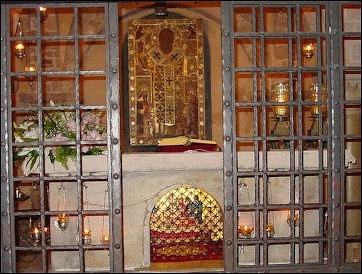
Relics of Saint Nicholas
“ The monks who were on watch, when they saw what had happened, began to wail aloud and cry: "He and he alone was our Father up to now, and never did he allow anyone to do such things. O how great and inconsolable an affliction has overtaken us!" At this juncture, Matthew, taking up the sacred remains, held them carefully. One of the two priests, Grimaldus by name, taking them as they were and placing them in his cloak, took possession of them with clear conscience. But his fellow sailors, wishing to carry off a certain sacred and pleasing ikon which was very old and depicted this most reverend and holy Father, were unable to accomplish this, in order that they might not be ignorant of this also, that the servant of Christ in no wise wished to leave his sanctuary entirely without a share of his holy blessing. And when the men had been assembled and had taken up their arms, they, together with the priest bearing the sacred remains on his shoulders, repaired to their ships, praising the ineffable providence and benevolence and power of God.
Candida Moss wrote in Daily Beast: To this day Italian Christians venerate the bones of St. Nicholas at the Basilica di San Nicola in Bari, where rumors swirled that the marble tomb excreted sweet-smelling “manna.” The liquid that dripped from the tomb was believed by many to be cure-all and was bottled for sale to pilgrims. It turned out to be water. Excavations in the 1950s revealed that the skeleton of “Nicholas” was resting in a pool of water, but the mechanics of the secretion remained debated (some argue it’s fraud, others that the stone tomb absorbs water from the ground and redistributes it to the tomb). But if the bones in the tomb under the church turn out to be those of Nicholas, then the Italian sailors stole fake relics. [Source: Candida Moss, Daily Beast, October 08, 2017]
For the complete article from which the material here is derived see “Transfer of the Body of Saint Nicholas from Myra in Lycia to Bari in Italy” by An anonymous 13th Century Greek Account, translated by J. McGinley and H. Mursurillo stnicholascenter.org
St. Nicholas Bones and Burial Spot Found?
In 2017, Turkish archeologists announced that they may have discovered the bones of St. Nicholas. The remains were unearthed beneath a 4th-century structure in Demre The discovery was made after digital analysis of the ground beneath the church. Archaeologists currently believe that the tomb has gone undisturbed since antiquity, but the mosaics on the floor make it difficult to excavate there. Cemril Karabayram, the head of Antalya’s Monument Authority, explained that specialists are unable to confirm the story until the floor of the church (which depicts scenes from the life of Nicholas of Myra) can be carefully removed. [Source: Candida Moss, Daily Beast, October 08, 2017]
In October 2022, archaeologists announced they had uncovered the original burial place of St. Nicholas at his church in Demre. Researchers knew that the saint's body was buried in the fourth century A.D. church there but his remains were stolen around 700 years after he died, so the specific spot where he was originally interred was a mystery. Clues found during new excavation of the church, similarities between it and the Church of the Holy Sepulchre in Jerusalem and the placement of a fresco depicting Jesus, hint at exactly where St. Nick's body was likely laid to rest. [Source: Kristina Killgrove, Live Science, October 19, 2022]
The church — the Church of St. Nicholas — was , built in A.D. 520 on top of an older church where the Christian saint served as bishop in the fourth century A.D. Live Science reported: The church of St. Nicholas in Demre itself has survived for more than a millennium, with archaeological excavation beginning at the end of the 20th century. Through this work, researchers discovered the foundations of the earliest church, covered by many feet of sand and silt. Last week, Osman Eravşar, chairman of the Antalya Cultural Heritage Preservation Regional Board, announced the discovery of the location of St. Nicholas's tomb at the base of a
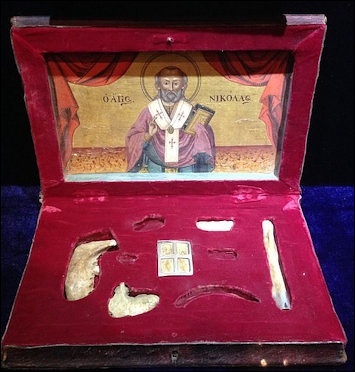
Saint Nicholas bones in Antalya, Turkey
In an interview with the Turkish news organization DHA, Eravşar noted that the current excavations have revealed "the floor on which St. Nicholas's feet stepped" from the original church. "This is an extremely important discovery, the first find from that period," DHA's English coverage quoted Eravşar as saying.The original burial place of St. Nicholas has also been found, according to Eravşar. When the Bari contingent removed the saint's bones in the 11th century, they also shoved some sarcophagi aside, obscuring their original location. Eravşar told DHA that "his sarcophagus must have been placed in a special place, and that is the part with three apses covered with a dome. There we have discovered the fresco depicting the scene where Jesus is holding a Bible in his left hand and making the sign of blessing with his right hand." A marble floor tile with the Greek words for "as grace" could mark his exact grave.
Supporting that hypothesis is the shape of the church itself. Just as the Church of the Holy Sepulchre has an unfinished dome on top, so does the Church of St. Nicholas at Myra. When it was restored by Emperor Alexander II of Russia in the 1860s, the dome was never completed. This unfinished dome may have been a purposeful attempt to link St. Nicholas with the story of Jesus's crucifixion and ascension into the sky. "It's not unusual for churches to be built atop one another," William Caraher, an archaeologist at the University of North Dakota with a specialty in early Christian architecture, who was not involved in the excavation, told Live Science in an email. "In fact, the presence of an earlier church on a site has been a reason to build a church since Early Christian and Byzantine times."
But Caraher thinks that the marble floor tile with Greek letters could be from some other context, reused possibly in antiquity because of the common word "charis" (grace) etched into it. Caraher noted that St. Nicholas is significant in Orthodox and Catholic traditions, with churches and chapels dedicated to him throughout the Mediterranean. "I think many people — from eager kiddos on Christmas Eve to world weary science reporters and grizzled archaeologists — have at some point in their lives hoped to get a little glimpse of the real St. Nick," Caraher said.
More Than a Million Russians Check Out Rib of Saint Nicholas
David Filipov wrote in the Washington Post: “They have come to pray for the health of loved ones. They have come to ask for help to pass a tough exam or just to get by in hard times. But mostly, they have come to be part of a once-in-a-millennium spiritual event: Saint Nicholas has come to town. Since relics of Russia’s most beloved saint were brought to Moscow on May 21, more than a million people have waited in line as long as 10 hours to spend just an instant at the gilded ark that holds one of his ribs. Lines to see the saint Russians call “the miracle worker” have stretched up to five miles from the giant, onion-domed Christ the Savior Cathedral, a reconstruction of a cathedral demolished by the Soviets in 1931. [Source: David Filipov, Washington Post, June 29, 2017]
Some waited to ask for a miracle from Saint Nicholas.“It’s important to be close to the grace of Saint Nicholas,” said Denis Knyazyev, 32, who drove four hours from his home west of Moscow to stand in line for Saint Nicholas last week. “All saints are special, but this is the one most dear to us.” What they see at the ark is an icon of Saint Nicholas, under a panel of bulletproof glass, with a crescent-shaped opening in the middle through which a bone is visible. As priests and burly security guards look on, a choir chants a harmonious prayer that echoes through the cavernous, ornate cathedral. But the music is drowned out by the stentorian instructions of volunteers in ―fluorescent-green vests.
They warn worshipers to cross themselves before they reach the ark and to have their prayers ready, to avoid backing up the line. As soon as the faithful bend to kiss the glass, a volunteer grabs them by the shoulders and nudges them, usually lightly, toward the exit. Those who linger get a special shove and an order to move on. Another volunteer wipes the glass with a cloth. But if this brusque treatment bothered anyone, it did not show. People coming out of the cathedral on a recent Friday expressed something resembling a combination of bliss over what they had seen and relief that they had survived the ordeal. “We were so afraid we wouldn’t make it,” a pregnant woman said through tears, as her husband comforted her.
Danila, a 14-year-old Muscovite, said he had “a magical feeling.” His mother added that “it was like God had heard me.” Saint Nicholas is special, said Maria Korovina, head of the Orthodox Church’s media center for special events, because of the role he plays in Russians’ lives — and the way these relics got here. “For 930 years, no one has seen them,” she said. “This is as though Saint Nicholas himself has come to Moscow.”

The decision to remove a rib and send it to Russia was a result of a historic meeting last year between Pope Francis and the head of the Russian Orthodox Church, Patriarch Kirill — the first such encounter since the 11th-century Great Schism that divided Christianity. On a recent Sunday evening, as the line meandered along a fenced-off sidewalk on the Moscow River embankment, through well-guarded police checkpoints and past well-stocked food ―kiosks and portable toilets, people wrote down prayers for the health of their loved ones as they whiled away the hours. Some fretted over whether they would get in before the cathedral closed for the night. But there was no need to pray for a miracle. The doors stay open until the last worshiper in line has made it inside.
Image Sources: Wikimedia Commons
Text Sources: Internet Ancient History Sourcebook: Christian Origins sourcebooks.fordham.edu “World Religions” edited by Geoffrey Parrinder (Facts on File); “ Encyclopedia of the World’s Religions” edited by R.C. Zaehner (Barnes & Noble Books, 1959); King James Version of the Bible, gutenberg.org; New International Version (NIV) of The Bible, biblegateway.com; Christian Classics Ethereal Library (CCEL) ccel.org , Frontline, PBS, Wikipedia, BBC, National Geographic, New York Times, Washington Post, Los Angeles Times, Smithsonian magazine, The New Yorker, Time, Live Science, Encyclopedia.com, Archaeology magazine, Reuters, Associated Press, Business Insider, AFP, Library of Congress, Lonely Planet Guides, Compton’s Encyclopedia and various books and other publications.
Last updated March 2024
